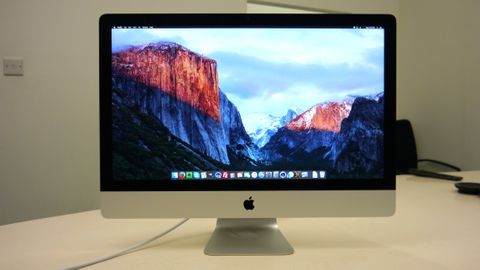TechRadar Verdict
Apple's best iMac gets even better thanks to a subtle, but noticable improvement in colour support, alongside Intel's latest Skylake processor.
Pros
- +
Display
- +
Peformance
- +
Sound
- +
Accessories
Cons
- -
Core i7 costs extra
- -
No height adjustability
- -
No Target Display Mode
Why you can trust TechRadar
When Apple introduced Retina displays on the iPhone 4 and iPad 3, those sharp screens made older models feel instantly outdated. Launched in late 2014, the first Mac with Retina 5K display had a similar effect. Featuring a display stuffed full of pixels, combined with powerful internals and the same sleek aluminum design that all-in-one PC makers still struggle to match, it rolled beauty and brawn into one attention demanding package.
Fast forward a year and there are still few options if you're looking for a 5K monitor. The Philips 5K LCD costs £1,050 (around US$1,514, or AU$2,055), while Dell's UP2715K brings 5K to its UltraSharp range for around £1,400 (around $1,409 or AUS$2,919). With the world still getting used to the delights of 4K, it's going to take time for affordable 5K panels hit the market.
Instead of resting on its laurels, Apple scrapped its non-Retina 27-inch iMac models (it still offers a non-Retina 21.5-inch iMac) and introduced three new 5K Retina iMacs sporting Intel's sixth-generation Skylake processors, upgraded AMD graphics and displays that boast a wider, multimedia-friendly DCI P3 colour gamut.

Design and ports
The new 5K iMac remains unchanged in the design department, and its size and weight are identical to before. The iMac's slim aluminum enclosure remains as impressive as the day Apple redesigned the line-up 2012. Its sloping curved back panel, which stores the computer's components, lends it the illusion that it's slimmer than it actually is.
The iMac remains an impressive feat of engineering that stands out even on the most mundane of desks, but there's still room for improvement. Apple could slim down black bezels surrounding the display, for example, to bring it in line with recent design trends. Monitors such as the Dell UltraSharp U3415W feature bezels that span mere milimetres, and the 5K iMac's are thick in comparison.

Another issue with the iMac's design is a lack of height adjustability. If you prefer to work with the display at eye level, the only option is to physically lift the machine onto a pile of books or a box, which can be a nerve-wracking experience considering its cost.
As has long been the norm for iMacs, ports are placed around the back on the left-hand side. The port placement makes it easy to feed cables through the tidy cable hole built into the stand. However, this comes at the expense of it being slightly awkward to connect or disconnect cables without standing up and peering around the back. On balance, it's still preferable to having wires awkwardly sticking out of the sides of the machine.
Display
The 5K iMac's 27-inch IPS display features brilliant viewing angles and is once again the star of the show. It's incredibly bright to the point of where I had to set the brightness down a notch or two in a dark room, and colours appear bold and vibrant with deep blacks. Tested with our ColorMunki i1DisplayPro, brightness was measured at an impressive 441 cd/m^2.
Elsewhere, it's business as usual - and that's no bad thing. A pixel-resolution of 5,120 x 2,880 means you can leave it on the default scaling (200%) and still have the same amount of desktop real-estate as you would on a 2,560 x 1,440 pixel-resolution monitor. The advantage is that icons, menus and high-resolution images are displayed with an astonishing level of detail. Even the El Capitan mountain range depicted in OS X 10.11's default wallpaper set takes on a new level of sharpness.

But the biggest story when it comes to the new iMac's display is that this year's model is capable of displaying 99% of the DCI P3 colour space, according to Apple. That's because it uses new red-green phosphor LEDs that can display a wider variation of green and red colours. DCI P3 is used by many professional DSLR and video cameras, meaning that any images shot using the RAW setting pack in more colour and appear true-to-life.
The difference is subtle but noticeable, and goes down as one more reason to plump for an iMac if you're a professional (or even hobbyist) image or video editor who's striving for greater colour accuracy.
On the flip side, Target Display Mode, which lets you connect and use consoles and other devices, is sadly still missing from the iMac, so you won't be able to use its gorgeous display as a monitor any time soon - and that's a huge shame. Perhaps a new Apple Cinema Display supporting DCI P3 is on the horizon.


